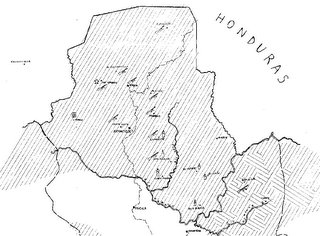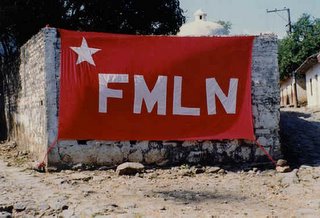I had been looking forward to reading his article "Hegemony in the Interior of the Salvadoran Revolution: The ERP in Northern Morazán," not least because I had assumed it would be a more theoretically robust defence of his approach. Unfortunately, it is not.

Northern Morazán was the area in which the FMLN had probably most secure hold throughout the war, and is where the so-called guerrilla capital, Perquín, was located. The area's prominence, however, is also due to the fact that it was the stronghold of what was the dominant and probably savviest of all the guerrilla forces that constituted the FMLN, the ERP (Ejército Revolucionario del Pueblo, or Revolutionary People's Army). On the one hand, this makes the region somewhat atypical of FMLN wartime experience and activity; on the other hand, it arguably provides particular insight into guerrilla organization and the likely shape of a post-revolutionary society, should the Revolution have been successful.
Binford's approach combines the concept of hegemony with the concepts of habitus and "field of power," these latter two terms drawn from the work of Pierre Bourdieu. His argument is that the FMLN embarked on "a double process of hegemony construction" (4), first among the civilians within the zone, and second (but at the same time) among their own guerrilla combatants. However, they were doubly constrained: first, by the fact that they were operating within what Binford calls a "military-political field of power" (4) within which the repressive state and its armed forces (literally) called many of the shots; and second, by the durability of pre-existing habitus, which included the machismo endemic among many of the guerrilla's own cadre and also the privileging of "household over collective production and individual over communal activity" among much of the peasantry (30).
In the end, then, Binford sees the FMLN's project as a failure, not simply because the Revolution never took place, but also (and perhaps this was the cause) because they were unable to effect durable change in people's pre-existing dispositions. In short, the "depth of ERP hegemony" (29) was at best shallow:
The motives of many participants remained instrumental, accompanied by only minor changes of consciousness, even if for some persons these practices contributed to the development of the "common meaningful and material framework" that is the sine qua non of hegemony (Roseberry 1994: 360-361). That that emergent framework never consolidated into a new "structure of feeling" (Williams 1977: 132) owed much to the short duration (eight years) and limited scope of the doble cara experiment [combining military and civil organization], which failed to reverse at the regional level well-entrenched cultural systems based on individualism and authoritarian control. (29-30)There is here significant confusion as to whether or not what's at issue is consciousness, as in a traditional conception of ideology and consciousness-raising, or practice, which would be more in line of Bourdieu's notion of habitus as embodied well beneath the level of ideology. Binford would no doubt suggest that the answer is both: he earlier suggests that ERP strategy was focussed on practice, on the attempt to develop new habits, "reconfiguring practices rather than projecting messages" (17), but that this was intended to ensure that "representations more appropriate to that situation--those promoted by the FMLN--would then stand a better chance of becoming generalized" (18). In what would appear to be a dialectical process, "the representations would reinforce practices and the military's real and symbolic power would suffer continuous erosion" (18).

The concept of hegemony that Binford adopts, taken solely from William Roseberry's "Hegemony and the Language of Contention" (and essentially from one sentence of Roseberry's at that) brings together these two aspects, of consciousness and practice, in its definition (much cited by Binford) of hegemony as a "common meaningful and material framework." Unfortunately, however, neither in Roseberry nor in Binford are the elements that constitute this phrase properly explored or unpacked. Throwing in then the notion of "structure of feeling," drawn from Raymond Williams, only adds to the murk. Hegemony becomes a catch-all category to designate any and all forms of social inequality, control, dominance, or inertia.
Binford employs these concepts more as totems than as analytical categories. This is most evident in his use of the term "field of power," almost always italicized within his text as if to signify both that it is somehow foreign, untranslated French taken straight from Bourdieu, and that it is special, possessed of some undefined and ineffable aura. Occasionally some specification is added: as well as the "military-political field of power" (4), Binford also writes of Northern Morazán simply as a "field of power" (8) when it is not a "social field of power" (9) or a "field of political-military power" (9), a "regional field of power" within "more encompassing fields of power" (11), or perhaps a "field of military power" (11) (emphases all in original). But it is not at all clear what differentiations, if any, are to be marked by these slight changes. They give the impression of complexity without actually enhancing our understanding.
So it is more generally with Binford's use of the term "hegemony." This is not, in the end, a theoretical concept. Or rather, it is "theory" (Theory?) only in the sense that those who oppose theory imagine: it is the use of a somewhat unfamiliar term to add the gloss of sophistication, but thereby mystifying what is in the end an analysis premised on no more than common sense.
And the problem here is that, shielded beneath this confused pseudo-theoretical armature, what remains most stubbornly resistant to critique is "common sense" itself.
No comments:
Post a Comment